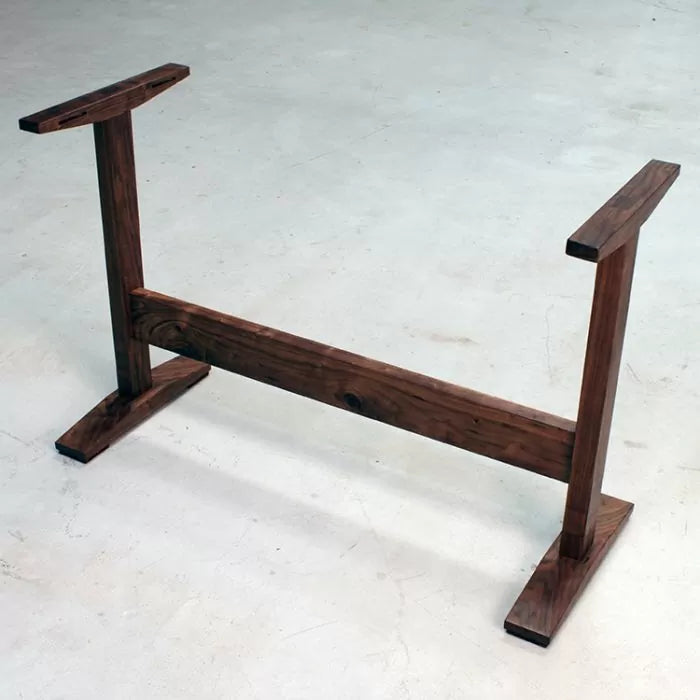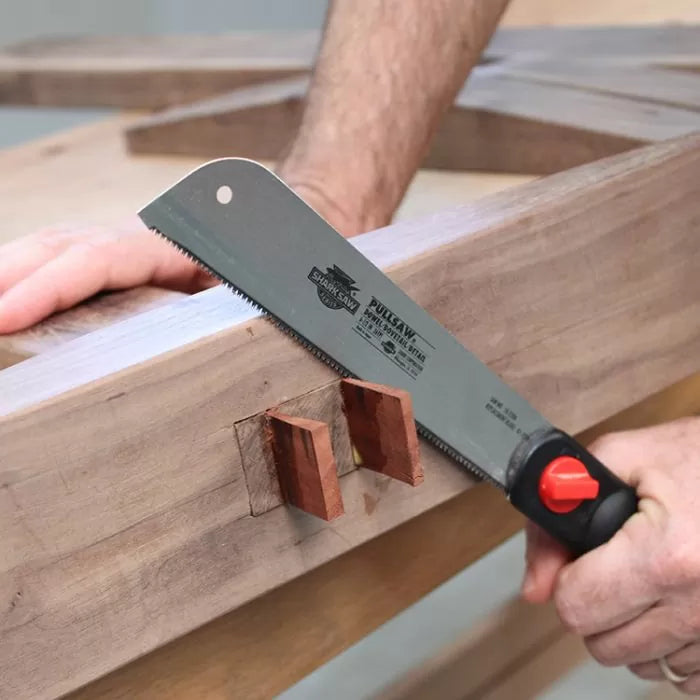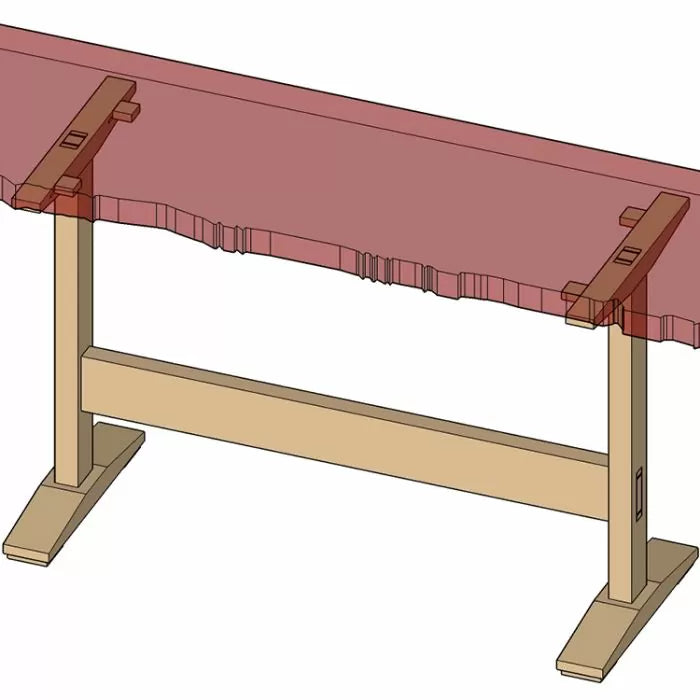Base for Live-Edge Slab Table Plans
In building our live-edge table, we've covered the top itself in parts 1 & 2. In part three we tackle the base. The base can be any design you'd prefer, but for our table we found there to be a couple of different options that tend to work well with a live-edge slab tabletop. Modern and Shaker design elements blend quite well with a live edge and don't look out of place. For my table I designed a base that has a little of both.

In Part One and Part Two of this Building a Live Edge Slab Table series I showed how I went about flattening, sanding, and finishing all parts of the slab in order to turn it into a tabletop. The last part of the puzzle is the table base. Of course, designing a base will always depend on personal taste but the addition of live edge can make this a little tricky. For instance, if I wanted a Queen Anne style table I would most likely not choose a live edge piece for the top. The same goes for a Federal or Arts and Crafts table. For me, I found there to be a couple of different options that tend to work well with a live-edge slab tabletop. Modern and Shaker design elements blend quite well with a live edge and don't look out of place. For my table I designed a base that has a little of both.

When designing the base for my table I tried to achieve two goals. First, I wanted the top to be the star of the show. I think of it as the diamond on an engagement ring. Second, I want the base to hold a few surprises for the person who eventually looks beyond the top for a little something extra. Another way of saying this is, I want the base to be subtle. The details I add are the type I would only expect myself and fellow woodworkers to notice or the owner, after a little time living with the piece. This is why I like to draw inspiration from Shaker furniture — the basic form is simple and elegant while remaining understated. At the same time I don't get too caught up in the Shaker ideology and will mix in my own creative twists. I think you get the idea so lets get on with it.

My design is simple: A trestle of American walnut to complement the warmth of the red eucalyptus top. I decided on a wedged, through tenon to join the stretcher to the legs, and a wide, yet shallow, foot to keep the piece grounded without feeling top-heavy. The stretcher is also low in the leg to add visual stability to the table. This is a thick, heavy top so I want to make sure the piece looks balanced to the eye. Make sure to check out the Project Plans and SketchUp model on the Infinity Cutting Tools website if you'd like to build a similar table of your own.

Construction is straightforward. I started with a piece of 8/4 walnut 10 feet long and 6" wide in the rough. With my plan in hand, I cut my pieces to rough length to make them easier to handle at the jointer and planer. I always try to work with shorter pieces whenever possible. Smaller pieces are easier to handle and less material is lost in the flattening process. This is because bow and twist are less pronounced vs. trying to joint and plane one long piece. I like to work with pieces from 3- to 5-feet long whenever possible. I find this to be the ideal length for your average jointer and planer.
You may be wondering what I mean when I say 8/4 walnut. This is the measurement of thickness for a piece of rough-sawn lumber and would be pronounced: "eight quarter." This means that the piece of material is eight quarters of an inch thick or 2". Other rough stock thicknesses you will see available are:
- 4/4 (four quarter, 1")
- 5/4 (five-quarter, 1-1/4")
- 6/4 (six-quarter, 1-1/2" )
- 12/4 (twelve quarter, 3")
- 16/4 (sixteen quarter, 4")
4/4 and 8/4 will be the most commonly available thicknesses. Rough sawn lumber is also most often sold in random widths and lengths, and the price is calculated by the board foot (bf).
To figure out how many board feet are in a board you use the following equation. Thickness in inches x Width in inches x Length in feet / 12 = Board Feet or ( T" x W" x L' / 12 = BF) My board of walnut was 2" thick, 6" wide, and 10' long. If I plug these numbers into my equation I get 2" x 6" x 10' / 12 = 10bf. If walnut is selling for $6 per board foot. My board would cost $60. If you're buying lumber don't be afraid to haggle on how many board feet you are being charged for. Most of the time I find that lumber yards will round down when a board is a few inches longer or a half an inch wider but some will charge by the inch using this equation. T" x W" x L" / 144 = BF. My same board measured in inches without rounding down would look like this. 2" x 6.1" x 126" / 144 = 10.675BF so the board would cost me an extra $4.05 at $6 per BF. The problem with this is I am paying from every inch even though the end is cut crooked and almost every board will have some form of check, crack, or defect at the end that needs to be cut off. Trust me, the lumber yard takes this into account and negotiates with the sawmill on these details as well.

With all my pieces jointed, planed, and cut to size I can start laying out my joinery. I decided to use all through-mortise and tenon joinery with wedges in the end of each to add a bit of detail and add strength to the joint. I will use offcuts from the tabletop to make the wedges which will add a splash of contrast. I defined the tenons in both ends of my vertical pieces and stretcher using an Infinity Tools Dadonator - 8" stacked dado blade set at the table saw. For the mortises, I first drilled out the majority of the waste with a Famag Forstner Bit at the drill press then squared up the mortise with a Narex premium bench chisel and Narex Premium large bench mallet.

When creating through mortises I'm always careful to work from both sides. I mark out the perimeter of the mortise front and back using a marking gauge like the iGaging wheel marking,mortising & depth gauge. I drill away as much of the waste as I can with a Forstner bit, then work to the line with a bench chisel. I chop 1/2 to 2/3 of the way through the thickness of the board, then flip the board over and finish to my line on the opposite side. In other words, I work from both sides and meet in the middle. This method helps ensure that I get a good, clean mortise with no blowout on either face. If I did my part when laying out my mortise location I should have nice straight, clean, and square joints.

I used an Infinity Dadonator at the table saw to cut my tenons. I set the dado blade to a 1/4" depth of cut and set my fence to create tenons 1-3/4" long, the same as my mortise depth. To make the slot for the wedges, I first lay out the location of the wedge then I drill a 1/4" hole at the base of the tenon using a brad point drill bit. This hole allows the tenon to more easily flex as the wedge is driven tight and helps prevent the possibility of a stress crack forming down the workpiece. Finally, I cut the slot for the wedge at the bandsaw. I used the 1/4" Olsen all-pro bandsaw blade I keep on my saw for general cutting. If a thicker wedge detail is desired the cut could be made at the table saw. I wanted a subtle detail for the wedge so the kerf of the bandsaw blade worked perfectly. Gluing up the mortise and tenon joinery is just a matter of applying Titebond II premium wood glue to the tenons, sliding everything together, then applying glue to the wedges and driving them home. I find that the wedges eliminate the need for clamps, but I do make sure that the tenon is fully seated into the mortise after driving the wedges to make sure there are no gaps. I also check that everything is nice and square before setting aside to dry.


I like to use a Shark pull saw to trim the wedges then sand smooth with a Mirka Deros sander. The Shark dowel/dovetail/detail saw is my favorite for this task.

I did all my detail work before assembly such as rounding all sharp corners with an Infinity 38-190 1/8"-radius roundover bit. The feet on the table base have a long bevel which adds an extra detail to the base. I roughed these bevels out at the bandsaw using an Infinity Rip Bandsaw Blade then sanded them smooth and to my line at the belt sander. I take my time here checking my progress often to keep the line of the bevel square to the sides. Once I have the bevels cut in all my pieces I gang them together at the workbench to sand all the feet smooth. I sanded all my pieces to 600 grit using Mirka Abranet sanding disks before assembly.

With the base glued up, I added foot pads to create a shadow line at the floor. I made the foot pads from off-cuts of the tabletop. They measure 1/2" thick by 3" square. I rounded the edges that would meet the floor with the same 1/8" radius bit I used for the rest of the table and glued them in place. Rather than try to clamp the pads while the glue dried I shot them with a couple of brads from my nail gun. I made sure the brads would not poke through the other side before nailing the feet home. I also ensured that the grain direction of the foot pad matched that of the foot, just in case of seasonal movement might encourage the glue to fail and the foot pad to pop free.

With the foot pads installed the final detail is to add a tabletop fastener to hold the top and base together. Rather than buy a tabletop fastener I decided to make my own from leftover walnut. I took a strip of 1-1/2" wide walnut and planed it to 5/8" thick then created a rabbet in the end with an Infinity Tools flat-top saw blade with a 1/4" kerf at the table saw. The rabbet measures 3/8" tall and 5/16" wide. This leaves a tongue that is 1/4" thick and 5/16" long. Finally I trimmed the piece to 1-3/4" long at the miter saw. I repeated the process 3 more times to give me 4 mounting blocks. The reason I make the blocks this way is so I have the best grain orientation for the block for strength. If the grain were to run across, rather than with the block, the tongue would most like break off under stress.
I use the Block to set the height of my Infinity 23-140B slot cutter router bit in my router and make a slot on the inside edge of the base top rails for the block to fit into. I make the slots 3" long and start them 2" from the end of the rails.

The final step is to drill a hole in the blocks and a countersink so the head of the screw will sit just below the surface. I'm a big fan of brad point drill bits and a Snappy countersink bit for this task. I like to use slotted brass screws in my furniture. No Philips heads for me if possible. I try to keep a set of screwdrivers specifically for driving brass screws. I have become quite fond of Narex screwdrivers and keep them as my "good" set in the shop. In other words, they don't get used to open paint cans or scrape glue.
Attaching the base is as simple as flipping the top over, preferably onto a blanket on the workbench, and locating the base on top. I slide the block in place and use a brad point bit to mark the location for the pilot hole in the tabletop. Using a brad point bit ensures that I transfer the mark accurately onto the tabletop for the screw pilot hole. It is very important with brass screws to drill the correct size pilot hole as the brass is soft and the head could easily strip or twist off if the hole is too tight. I also like to add a bit of wax to the threads to reduce friction. The beauty of this system is that it holds the top to the base but still allows the top to expand and contract without the risk of the top splitting.

Similar to the live edge slab top, I finished the base with Odie's Oil. Because I sanded the base to 600-grit I only needed to apply two coats of oil to the base to achieve the look and protection I need. I will often leave the base with a little less shine than the top to help the top stand out. Remember, the top is like the diamond on an engagement ring.
Application of the oil is easy, rub on a thin coat of Odie's Oil, let it soak in for 30 minutes to an hour, then buff everything off the surface and let dry.
The final thing left to do is sign the project. Oftentimes when we reach the end of a project we are so tired of it that it doesn't get signed. I have made it a habit to build projects from start to finish knowing that when I'm done I must sign them regardless of size or complexity. This single fact helps me stay focused because if I start thinking about cutting a corner or leaving out a detail, I won't be happy signing the piece. I often joke that my hope for my furniture is that in 200 years someone will bring it to the Antiques Roadshow and the furniture appraiser will be excited to find my name — and hopefully recognize it. While this will most likely not happen, I do know that the few tools I have that belonged to my great grandfather have a great deal of sentimental value to me. One day my descendants may feel the same about a piece of furniture I have made. The fact that they know without a doubt that I made the piece just might make the connection for them that much stronger. If you take the time to build something, take pride and put your name on it.











